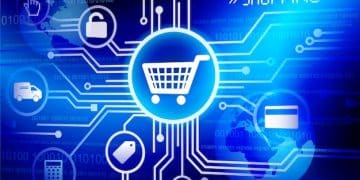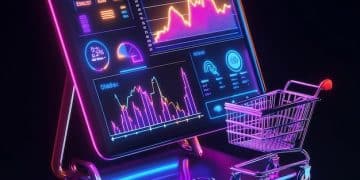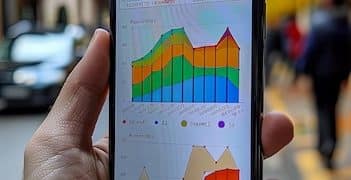Boost E-commerce Conversions 15% with 2025 Google Ads
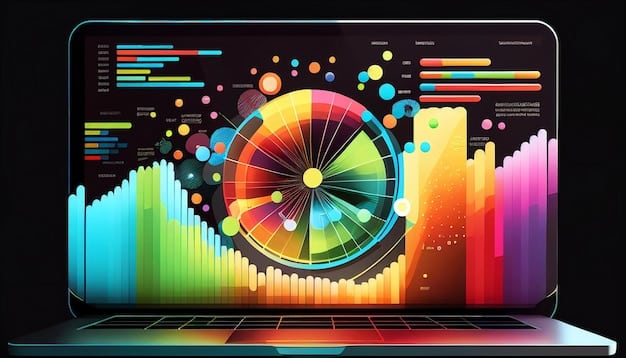
Achieving a 15% increase in e-commerce conversion rates by 2025 demands a strategic pivot towards advanced Google Ads techniques, integrating AI-driven automation, enhanced data analytics, and a customer-centric campaign structure focused on personalized user journeys.
The landscape of e-commerce is in constant flux, with consumer expectations and technological advancements reshaping how businesses connect with their audience. For online retailers aiming to significantly boost their sales, specifically targeting a 15% increase in conversion rates, a sophisticated approach to Google Ads is no longer optional—it’s essential. This guide delves into actionable, forward-thinking Google Ads strategies designed to help your e-commerce venture achieve substantial growth by 2025, ensuring your campaigns are not just optimized, but future-proofed. Learn how to increase e-commerce conversion rates by 15% using updated Google Ads strategies in 2025 by adapting to emerging trends and leveraging advanced features.
Mastering AI and Automation in Google Ads for E-commerce
Artificial intelligence (AI) and automation are no longer buzzwords but foundational pillars of successful Google Ads campaigns, especially for e-commerce. By 2025, leveraging these technologies will be paramount to gain a competitive edge and significantly enhance conversion rates. The sophistication of Google’s algorithms allows for unparalleled targeting, bidding, and ad creativity, which when properly utilized, can drive substantial business growth.
The core benefit of AI in Google Ads lies in its capacity to process vast amounts of data at speeds and scales unreachable by human analysis. This enables dynamic adjustments to campaigns, optimizing for various signals like user behavior, device, location, and time of day. Businesses focused on improving their conversion rates must embrace these tools, moving away from manual, time-consuming optimizations towards a more strategic, automated approach.
Leveraging Smart Bidding Strategies
Google Ads’ Smart Bidding strategies, powered by AI, are designed to optimize for specific conversion goals. By 2025, these strategies will be even more refined, adapting to real-time signals with greater precision. Moving beyond basic Target CPA or Maximize Conversions, consider a deeper dive into their potential:
- Enhanced Conversion Tracking: Ensure your conversion tracking is meticulously set up, including micro-conversions, to feed accurate data to the AI. This is the bedrock of effective Smart Bidding.
- Value-Based Bidding: For e-commerce, optimizing for conversion value (like Target ROAS) is crucial. AI can learn which products and customer segments yield higher revenue, dynamically adjusting bids to maximize return on ad spend.
- Experimentation with Bid Strategies: Don’t just set and forget. Continuously A/B test different Smart Bidding strategies to determine which performs best for various product categories or campaign types.
Beyond bidding, AI also plays a critical role in audience segmentation and ad serving. It identifies patterns in user behavior that might indicate purchase intent, allowing for hyper-targeted ad delivery. This means showing the right product to the right person at the right time, dramatically increasing the likelihood of a conversion.
Automation extends to routine campaign management tasks, freeing up marketers to focus on higher-level strategy. This includes automated reporting, budget allocation, and even initial ad copy generation. Embracing these automated workflows is key to scaling e-commerce operations efficiently, allowing for rapid adaptation to market changes and consumer trends.
In summary, embracing the full spectrum of AI and automation within Google Ads is not just about efficiency; it’s about unlocking new levels of performance. By 2025, e-commerce businesses that effectively integrate these tools will be well-positioned to achieve and even surpass their conversion rate goals, transforming complex data into actionable insights and profitable outcomes.
Advanced Audience Targeting and Personalization
Simply reaching a large audience is no longer enough to drive significant e-commerce conversions. By 2025, the focus must shift towards precision and personalization, leveraging Google Ads’ advanced targeting capabilities to connect with the most valuable customer segments. This involves understanding customer journeys in intricate detail and delivering highly relevant messages that resonate with individual needs and preferences.
The modern consumer expects a personalized experience, from the initial ad impression to the final purchase. Generic campaigns often fall flat, leading to wasted ad spend and missed conversion opportunities. Therefore, e-commerce businesses need to move beyond broad demographic targeting and delve into behavioral and intent-based signals to capture attention effectively.
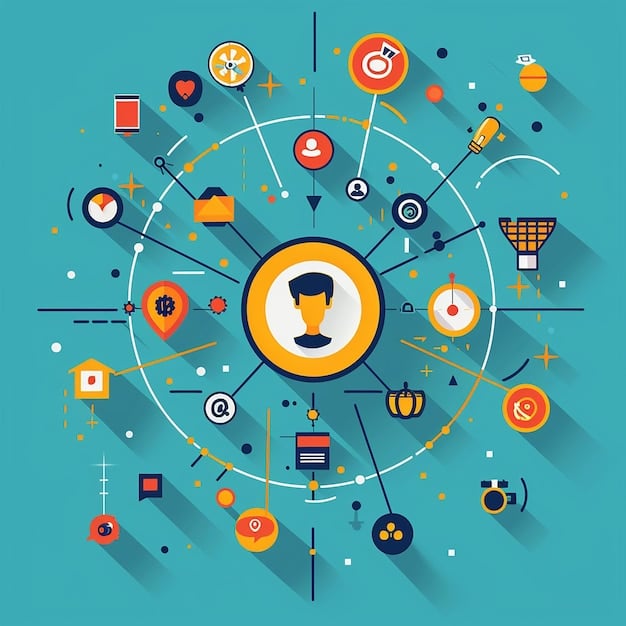
Deep Dive into Customer Match and Custom Audiences
While Customer Match has been around, its utility will only grow by 2025. Uploading customer data (like email lists) allows you to target existing customers or create look-alike audiences, ensuring your ads reach those most likely to convert:
- Re-engagement Campaigns: Target past purchasers with complementary products or special offers. This leverages existing customer relationships, which often have higher conversion probabilities.
- High-Value Customer Look-alikes: Identify your top-spending customers and use Customer Match to find new users with similar characteristics and online behaviors.
- Exclude Unprofitable Segments: Use negative customer lists to avoid showing ads to users highly unlikely to convert, saving ad spend.
Custom Audiences, allowing you to target users based on their search terms, visited websites, or app usage, offers another layer of precision. This is particularly powerful for capturing users actively researching products or services similar to yours, indicating high purchase intent. Crafting unique ad copy and landing page experiences for these custom segments can significantly boost engagement and conversions.
Furthermore, the integration of first-party data will be critical in a privacy-centric future. Businesses should prioritize collecting and leveraging their own customer data to inform targeting decisions, reducing reliance on third-party cookies. This not only builds a more resilient advertising strategy but also fosters deeper customer understanding.
Dynamic Creative Optimization (DCO) will enable advertisers to serve personalized ad variations based on audience segments, real-time context, and even individual user preferences. Imagine an ad showing a user precisely the product they viewed on your site, with a special discount just for them, based on their browsing history. This level of personalization moves beyond basic re-marketing, creating a far more compelling call to action.
In essence, advanced audience targeting is about seeing your customers not as a monolithic group, but as individuals with unique needs and journeys. By employing Customer Match, Custom Audiences, and embracing personalization, e-commerce businesses can craft campaigns that truly resonate, translating into a significant uplift in conversion rates by 2025.
Optimizing Product Feeds for Performance Max Campaigns
Performance Max campaigns are Google’s answer to consolidating various campaign types into a single, AI-driven solution geared towards maximizing conversions. For e-commerce, the success of Performance Max hinges almost entirely on the quality and optimization of your product feed. By 2025, a meticulously crafted product feed will be the unsung hero behind skyrocketing conversion rates.
Unlike traditional Shopping campaigns where your feed primarily informs product listings, in Performance Max, it’s a central data source that fuels ads across all of Google’s inventory—Search, Display, YouTube, Gmail, and Discover. This means a suboptimal feed can cripple your campaign’s ability to reach the right audience with the right message, ultimately impacting conversions.
Key Elements of a High-Performing Product Feed
To ensure your product feed is conversion-ready for Performance Max in 2025, focus on these critical elements:
- Rich Product Titles: Go beyond basic product names. Include crucial keywords, brand names, product attributes (size, color, material), and even target demographics when relevant. These titles are often the first thing users see and are heavily weighted by Google’s algorithms. Example: “Red Ray-Ban Wayfarer Sunglasses UV400 Protection Men’s”.
- Compelling Product Descriptions: Use clear, keyword-rich descriptions that highlight benefits, features, and unique selling propositions. Avoid boilerplate text; make each description unique and informative.
- High-Quality Images: Visuals are paramount in e-commerce. Ensure your product images are high-resolution, showcase the product clearly, and ideally include multiple angles or lifestyle shots. Google’s AI can analyze image content, making quality a ranking factor.
- Accurate Product Categorization: Use Google Product Categories correctly. This helps Google understand your products and show them to relevant search queries. Incorrect categorization can lead to misdirected ad impressions.
Updating your product feed frequently is equally important. Stock levels, price changes, and new product additions should be reflected in real-time. Stale data can lead to a poor user experience—e.g., clicking on an ad for an out-of-stock item—and ultimately, lost conversions and a negative campaign performance signal to Google.
Beyond the basics, consider adding custom labels to your product feed. These labels allow for granular segmentation within Performance Max, enabling you to group products by profitability, seasonal trends, promotions, or even strategic importance. This level of control empowers you to bid more aggressively on high-margin items or promotional products, optimizing for value rather than just volume.
Furthermore, ensure your landing pages are consistent with your product feed data. Any discrepancy between the ad copy generated from your feed and the landing page experience can create friction for the user, deterring them from completing a purchase. A seamless user journey from ad to product page is critical for maximizing conversions, especially with the high volume of traffic driven by Performance Max.
In essence, a well-optimized product feed is the fuel for high-performing Performance Max campaigns. By investing in its quality and real-time maintenance, e-commerce businesses can harness the full power of Google’s AI to drive a significant increase in conversion rates by 2025, ensuring their products are seen by the right buyers at the opportune moment.
Leveraging First-Party Data & Enhanced Conversion Tracking
In an increasingly privacy-focused digital landscape, relying solely on third-party cookies is becoming obsolete. By 2025, e-commerce businesses will need to prioritize the collection and utilization of first-party data coupled with advanced conversion tracking to accurately measure campaign performance and drive conversion growth. This shift is not just about compliance; it’s about building a more resilient and effective advertising strategy.
First-party data—information collected directly from your customers with their consent—provides unparalleled insights into their preferences, behaviors, and purchase history. When integrated effectively with Google Ads, this data becomes a powerful tool for personalization, retargeting, and optimizing ad spend, directly impacting conversion rates.
Implementing Enhanced Conversions and Google Tag Manager
Enhanced Conversions is a Google Ads feature that improves the accuracy of your conversion measurement by supplementing existing conversion tags with hashed first-party customer data from your website. This is crucial for navigating data privacy changes and ensuring Google’s AI has sufficient data to optimize effectively.
- User consent management: Implement robust consent management platforms (CMPs) to collect user data ethically and transparently, adhering to regulations like GDPR and CCPA.
- Google Tag Manager (GTM) for precision: Use GTM to manage your conversion tags with greater flexibility and control. GTM allows you to implement Enhanced Conversions and other tracking parameters without direct code modification, reducing errors and ensuring data accuracy.
- Offline conversion import: If your e-commerce model includes offline sales stemming from online interactions (e.g., phone orders), import this data into Google Ads. This provides a complete picture of customer value and helps the AI optimize for true revenue generation.
Beyond raw data, it’s about connecting the dots. Understanding the entire customer journey, from initial ad click to post-purchase engagement, helps identify potential conversion blockers and opportunities for improvement. This might involve setting up comprehensive event tracking in Google Analytics 4 (GA4) and linking it seamlessly with Google Ads.
The synergy between first-party data and advanced tracking allows for more sophisticated audience segmentation. You can create segments based on specific product views, abandoned carts, loyalty program membership, or even previous support interactions. Each segment can then be targeted with custom ad campaigns designed to address their unique stage in the buying cycle, drastically improving conversion potential.
Moreover, the deprecation of third-party cookies makes first-party data invaluable for measuring the effectiveness of display and remarketing campaigns. By maintaining direct relationships with your customers and collecting their data responsibly, you can continue to deliver personalized experiences even as the privacy landscape evolves.
In conclusion, a proactive approach to first-party data collection and the implementation of Enhanced Conversions with a robust GTM setup are non-negotiable for e-commerce success by 2025. These strategies ensure superior data accuracy, empower Google’s AI for better optimization, and ultimately lead to a significant uplift in overall conversion rates.
Creative Optimization and Dynamic Ad Experiences
In a saturated digital marketplace, captivating visuals and compelling ad copy are more important than ever for e-commerce businesses aiming to increase conversion rates. By 2025, static ads will yield diminishing returns, necessitating a shift towards dynamic, creative optimization and rich ad experiences that resonate deeply with individual users. The goal is to move beyond mere product display to creating an immersive and persuasive brand story within the ad itself.
Google Ads offers an array of features designed to enhance creative impact, from responsive search ads that adapt to search queries to dynamic display ads that personalize content based on user behavior. The challenge lies in strategically leveraging these tools to not only catch the eye but also effectively drive the desired action: a purchase.
Harnessing Responsive Search Ads and Dynamic Display
Responsive Search Ads (RSAs) are a cornerstone of modern Google Ads strategy. By providing multiple headlines and descriptions, Google’s AI tests various combinations to determine which performs best for different search queries and user contexts. Key to maximizing their impact are:
- Diverse Ad Assets: Provide a wide variety of strong, unique headlines and descriptions. Include keywords, calls to action, unique selling propositions, and emotional triggers. The more options you give Google, the better it can optimize performance.
- Pinning Strategic Assets: While letting the AI experiment is good, consider pinning specific headlines or descriptions if they contain crucial information that must always appear (e.g., brand name, specific promotion). Use this sparingly to allow for maximum flexibility.
- Regularly Reviewing Asset Performance: Monitor the “Asset Report” in Google Ads to identify underperforming assets and replace them, continuously refining your ad messaging.
Dynamic Display Ads take personalization to the next level. For e-commerce, these ads can dynamically pull product images, prices, and descriptions directly from your product feed, tailoring the ad creative to specific user interests based on their browsing history on your site. This re-marketing powerhouse ensures users see products they have already expressed interest in, significantly increasing the likelihood of conversion.

Beyond traditional ad formats, explore richer media types. Video ads on YouTube and Discovery Campaigns, utilizing high-quality product showcases or testimonials, can build brand affinity and drive conversions by offering a more engaging format. Even within static image ads, consider using dynamic image extensions that automatically select the most relevant images from your landing pages, enhancing visual appeal.
The “ad experience” also extends to the seamlessness between the ad and the landing page. Ensure your landing pages are mobile-responsive, load quickly, and directly correspond to the ad’s promise. A disjointed experience creates frustration and leads to abandonment, negating the effort put into creative optimization. A/B testing different landing page designs and calls to action against specific ad creatives can yield significant insights and conversion gains.
In conclusion, successful e-commerce conversion growth by 2025 will hinge on a dynamic and intelligent approach to ad creative. By fully embracing responsive formats, dynamic personalization, and richer media, businesses can create ad experiences that not only capture attention but convert it into tangible sales, driving that crucial 15% increase.
Integrating Google Analytics 4 for Deeper Insights
Google Analytics 4 (GA4) represents a fundamental shift in how businesses measure user engagement and conversions. For e-commerce, a comprehensive understanding and integration of GA4 with Google Ads will be absolutely critical by 2025 to uncover deeper insights, optimize campaign performance, and ultimately increase conversion rates. Moving beyond the session-based model of Universal Analytics, GA4’s event-centric approach provides a more holistic view of the customer journey, spanning across devices and platforms.
The power of GA4 for e-commerce lies in its ability to track a wider range of user interactions as “events”—from product views and cart additions to video plays and form submissions. This granular data allows for a more accurate attribution of conversions and identification of critical points in the user funnel, which can then inform Google Ads strategies.
Leveraging GA4 Data for Google Ads Optimization
To maximize the impact of GA4 on your Google Ads conversion rates, focus on these integration points:
- Enhanced E-commerce Tracking: Implement GA4’s enhanced e-commerce tracking to precisely monitor every step of the purchase funnel, from item list views to transactions. This data is invaluable for identifying drop-off points.
- Audience Creation and Export: Build highly specific audiences in GA4 based on user behavior (e.g., “users who viewed product X but didn’t purchase,” “users who added to cart but abandoned”). Export these audiences directly to Google Ads for targeted re-marketing and exclusion lists.
- Predictive Audiences: GA4’s machine learning capabilities can create “predictive audiences,” such as users “likely to purchase in the next 7 days.” Targeting these high-intent users with specific Google Ads campaigns can significantly boost conversion efficiency.
Furthermore, GA4’s cross-device tracking capabilities provide a more accurate picture of a user’s journey, even when they switch between phone, tablet, and desktop. This prevents fragmented conversion data and helps Google Ads optimize more effectively for complex conversion paths. Understanding whether a user starts their journey on a mobile ad and converts later on a desktop can reshape your bidding and targeting strategies.
The Google Ads-GA4 integration also strengthens the feedback loop for Smart Bidding. By feeding more accurate and comprehensive conversion data from GA4 into Google Ads, the AI has better information to make real-time bidding decisions, optimizing for users who are truly likely to convert and generate revenue. This ensures your ad spend is directed towards the most profitable opportunities.
Beyond direct conversion tracking, GA4 provides valuable insights into user engagement metrics like average engagement time, engaged sessions, and events per session. These metrics can indirectly inform ad creative and landing page optimizations. For instance, if certain product pages have low engagement time, it might signal a need for clearer product descriptions or improved imagery, indirectly impacting the conversion rate driven by Google Ads traffic.
In conclusion, neglecting the power of Google Analytics 4 means operating with an incomplete picture of your e-commerce performance. By fully integrating GA4 with your Google Ads accounts by 2025, businesses can unlock deeper behavioral insights, create more precise audiences, and empower Google’s AI with richer data, all critical steps toward achieving a 15% increase in conversion rates.
Future-Proofing Your Google Ads Strategy for 2025
The digital advertising landscape is dynamic, with technological advancements and privacy concerns continuously reshaping best practices. For e-commerce businesses aiming to sustain and grow conversion rates by 15% by 2025, future-proofing their Google Ads strategy is paramount. This involves not just adopting current best practices but anticipating future trends and building a flexible, adaptable framework.
A static approach to Google Ads will inevitably lead to stagnation. Instead, businesses must cultivate a culture of continuous learning, experimentation, and rapid adaptation. This proactive mindset ensures that as Google’s platform evolves and consumer behaviors shift, your e-commerce conversion efforts remain at the forefront.
Embracing Privacy-Centric Advertising
With the ongoing changes in data privacy regulations and the deprecation of third-party cookies, an imperative for 2025 will be:
- Consent Mode Implementation: Ensure Google Consent Mode is correctly implemented, allowing Google to adjust its tracking behavior based on user consent. This helps preserve valuable conversion data while respecting user privacy.
- First-Party Data Strategy: Continually enhance your first-party data collection methods, offering clear value propositions to users for sharing their data. This reduces reliance on external tracking and builds direct customer relationships.
- Server-Side Tagging: Explore server-side tagging for improved data accuracy, security, and performance. This can help bypass some browser restrictions and provide a more robust data stream to Google Ads.
Beyond privacy, the evolution of AI and machine learning will demand increased trust and understanding of algorithmic black boxes. Marketers will need to shift from manually tweaking bids to strategically guiding the AI with clear goals, robust data, and well-structured campaigns. This means focusing more on strategic input and less on granular, day-to-day adjustments.
Diversification of ad formats and platforms will also be key. While Google Ads is powerful, exploring other channels that complement your Google Ads efforts, such as social media advertising or emerging commerce platforms, can create a more resilient marketing ecosystem. Understand how different touchpoints contribute to the overall customer journey and conversion funnel.
Staying informed about Google’s announcements and betas is crucial. Google frequently rolls out new features and updates that can significantly impact campaign performance. Participating in beta programs or regularly reviewing industry publications ensures you’re among the first to adopt advantageous new tools or adapt to upcoming changes.
Finally, fostering an experimental mindset is perhaps the most important aspect of future-proofing. What works today may not work tomorrow. Regularly testing new ad creatives, bidding strategies, audience segments, and landing page designs will allow you to identify new opportunities and stay ahead of the curve. This continuous optimization loop is the ultimate strategy for sustained conversion rate growth.
In essence, future-proofing by 2025 means being agile, privacy-conscious, AI-fluent, and committed to continuous learning. By embedding these principles into your Google Ads strategy, e-commerce businesses can confidently navigate the evolving digital landscape and achieve their ambitious conversion rate targets.
| Key Strategy | Brief Description |
|---|---|
| 🤖 AI & Automation | Leverage Smart Bidding and AI-driven campaign optimizations for dynamic, real-time performance. |
| 🎯 Advanced Targeting | Utilize Customer Match and Custom Audiences for pinpoint precision and personalization. |
| 🛍️ Product Feed Optimization | Ensure a rich, updated product feed for Performance Max campaigns across all Google properties. |
| 📊 GA4 Integration | Integrate Google Analytics 4 for deeper insights, custom audiences, and robust conversion tracking. |
Frequently Asked Questions About E-commerce Google Ads
While industry benchmarks vary widely, a “good” e-commerce conversion rate on Google Ads in 2025 is often considered to be between 2% and 5%. However, elite performers can achieve rates significantly higher, sometimes exceeding 10%, especially with highly targeted remarketing campaigns or niche products. The ultimate goal is continuous improvement, aiming to surpass your own historical performance.
AI in Google Ads enhances e-commerce conversions by optimizing bids in real-time, matching products to user intent more accurately, and personalizing ad experiences at scale. It identifies complex patterns in user behavior and market signals to show the right ad to the right person at the optimal moment, leading to higher likelihoods of purchase completions and improved campaign efficiency.
Product feed optimization is crucial for Performance Max because the feed acts as the central data source for creating dynamic ads across all Google channels. A well-optimized feed with rich titles, accurate descriptions, and high-quality images allows Google’s AI to understand your products better and generate more relevant and compelling ads, directly impacting conversion performance and visibility.
First-party data is vital for future Google Ads strategies as it provides accurate, privacy-compliant insights into your actual customers. It enables highly specific audience targeting, personalized ad creative, and more precise conversion measurement, especially as third-party cookies diminish. Leveraging this data helps in building resilient, high-performing campaigns that adapt to evolving privacy standards while driving conversions.
Google Analytics 4 (GA4) boosts Google Ads conversion rates by offering event-based tracking that provides a more complete, cross-device view of the customer journey. You can create advanced audiences in GA4 based on user behavior and export them to Google Ads for targeted campaigns. Its predictive capabilities also help identify high-intent users, allowing for more strategic ad spend and optimized bidding decisions, leading to higher conversions.
Conclusion
Achieving a 15% increase in e-commerce conversion rates by 2025 through Google Ads is an ambitious yet entirely attainable goal for businesses willing to embrace strategic innovation. The key lies in moving beyond traditional methods and adopting a sophisticated, data-driven approach. By mastering AI and automation, implementing advanced audience targeting, meticulously optimizing product feeds for Performance Max, leveraging first-party data with Enhanced Conversions, and integrating the powerful insights from Google Analytics 4, e-commerce retailers can build a robust and future-proof advertising strategy. The digital landscape demands agility and a commitment to continuous optimization; those who adapt will not only meet but exceed their conversion targets, positioning themselves for sustainable growth in a competitive online market.
